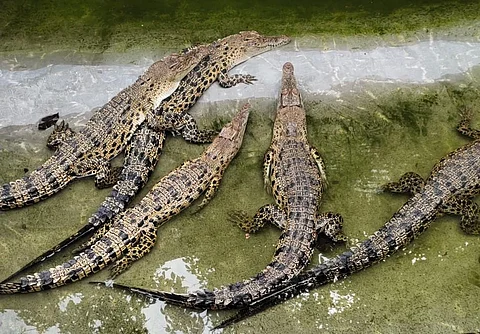

BHUBANESWAR: India’s saltwater crocodile conservation programme, one of the success stories in the last 48 years, is staring at new challenges. From local extinction in Kerala and Tamil Nadu to proposals in the past to delist the salties in the Union Territory of Andaman and Nicobar Islands, it has reached a point where discussion on scientific management is crying out for attention.
The rising conflict in Odisha’s Bhitarkanika National Park is the newest addition to the conservation management debate. A growing density of reptiles and the ever-increasing anthropogenic pressure has resulted in at least 10 fatalities in crocodile attacks in the past year.
The crocodile conservation programme through captive breeding started in India around 1974-75 after indiscriminate killing and habitat loss pushed the population of estuarine crocodiles to the brink of extinction. The government-run programme was launched in Odisha in collaboration with UNDP and Food and Agricultural Organisation (FAO) in 1975.

This coupled with other measures, including notification of Bhitarkanika as a wildlife sanctuary, contributed significantly to the revival of the population in the next two decades. As the number increased—from just around 96 in 1974 to over 1,000 in 1995—the Forest Department had to stop the breeding programme.
The protection measures put in place, however, continued to supplement the growth of the estuarine crocodiles. With a head count of 1,793, Bhitarkanika is now home to nearly 70% of India’s saltwater crocodile population. However, what has presented a problem is the density of the saltwater crocodile—it has already surpassed the density of five to six crocodiles per square km of water.
This has started throwing fresh challenges primarily due to equally growing human activities and increasing dependency of people on Bramhani and Kharasrota rivers as well as local nullahs and water-bodies in and around Bhitarkanika national park, a vibrant mangrove eco-system of India.
Inadequate household piped water connection in the fringe villages as well as the natural dependence on the river as part of socio-cultural behaviour has only led to escalating conflicts as spillover population of crocodiles show up near human habitations.
The Odisha Forest Department, in response, unfurled a spate of public awareness programmes to arrest the conflict in the river-dependent villages.
However, experts feel the current situation in Bhitarkanika underlines the need for appropriate intervention to encourage human-crocodile coexistence in a sustainable manner. Shesdev Patro and Sunil Kumar Padhi, two researchers from Berhampur University in Odisha, in their study titled ‘Saltwater crocodile and human conflict around Bhitarkanika National Park, India: A rising concern for determining conservation limits’, underlined the need to re-think the strategy.
“The scenario has risen to an alarming stage where we have to rethink the conservation strategy of the species and develop a suitable management plan for the coexistence of these reptiles and the inhabitants in their surroundings,” the paper said.
The study authors say the conservation and management strategy of estuarine crocodiles should include the determination of the carrying capacity of the sanctuary, minimising exploitation of natural resources, relocation of excess population to other feasible sites and local awareness among others.

Herpetologist and scientist from the Zoological Survey of India Pratyush Mohapatra feels the strategies need to be localised and case-specific when it comes to measures required to prevent conflict.
He says it is extremely important to raise awareness about the behaviour of these reptiles and plans to avoid man-crocodile conflict but underlines the need for creating rapid response teams to relocate crocodiles.
“Mapping the density and spillover population regions is a must besides putting in place rapid response teams by the Forest department. These teams must respond within two to three hours and be equipped with infrastructure,” Mohapatra says.
Experts point out that timely intervention is extremely important which otherwise may affect conservation as it happened in southern Indian states where the presence of saltwater crocodile species has dwindled.